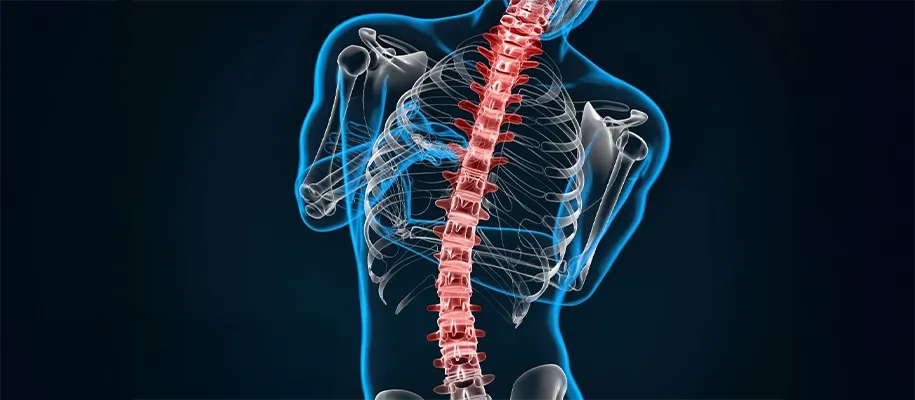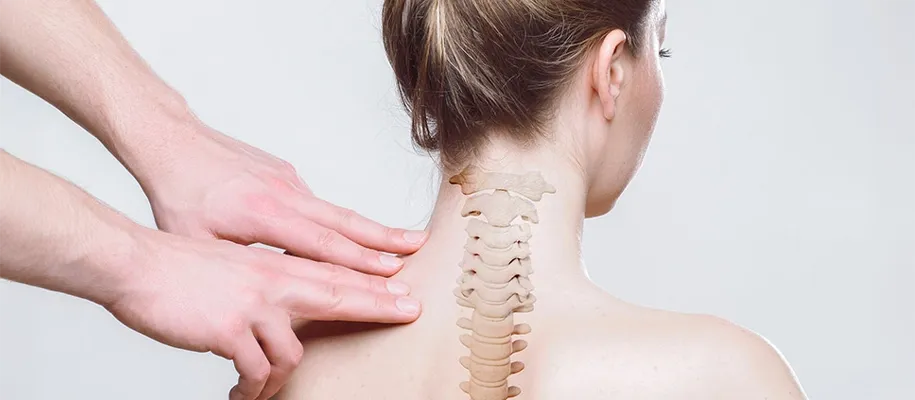The spine is a structure that protects the spinal cord, provides support to the body allowing movement.
Although we speak of it in singular, it consists of a complex row of 33 vertebrae, intervertebral discs, nerve roots and ligaments that work together to achieve functional harmony.
However, this is not always the case and there may be malformations, wear and tear, injuries or accidents. When this interruption occurs, it often results in instability or back pain.
Back pain is a universal experience, but its causes are very diverse.
There are pains that are similar even in name, which frequently causes confusion and can lead to misunderstandings about their cause and treatment.
Today I'll tell you about the main differences between spondylosis, spondylitis, spondylolysis and spondylolisthesis. Although they sound similar, they describe different pathologies
Spondylosis
What is Spondylosis? Degeneration of the Spinal Column
Do you have pain in your back and neck? Spondylosis is a disorder of abnormal wear and tear on the cartilage of the discs and cervical vertebrae causing chronic pain. Usually caused by aging affecting people over 60 years old. Sometimes this wear can present with bone spurs on the vertebrae.
Causes and Risk Factors of Spondylosis: The Passage of Time
Dehydrated Discs: Intervertebral discs, which act as shock absorbers between vertebrae, begin to dehydrate and shrink around age 40 causing them to impact each other.
Herniated Discs: Disc deterioration can lead to cracks in the outer part of the discs making it more likely to compress nerve roots or the spinal cord.
Bone Spurs: In response to disc deterioration, the body may produce additional amounts of bone in an attempt to strengthen the spine. These bone growths can crush the spinal cord and nerve roots, causing pain.
Stiff Ligaments: Reduces flexibility of the neck and back contributing to limited mobility and pain.
Other factors besides aging include: repetitive movements and uncomfortable postures at work, previous injuries, genetic factors and smoking that affects overall bone quality.
Key Symptoms of Spondylosis and When to Seek Medical Attention
Spondylosis is often asymptomatic, meaning many people may have the condition without experiencing pain or discomfort. When symptoms do occur, they vary depending on the region of the spine affected.
Cervical Spondylosis (neck): The most common symptoms include neck pain and stiffness, which may worsen with activity. It's common to experience headaches, especially at the back of the head, and a grinding sensation when turning the neck.
Pain may radiate from the shoulder blade to the arm and forearm, and there may be numbness or tingling in the shoulders or arms. Pain may manifest when sitting for long periods, standing, or bending the neck backward. In more severe cases, if the spinal cord or nerve roots are compressed, symptoms such as tingling, numbness and weakness in the arms, hands, legs or feet, lack of coordination, difficulty walking, and even loss of bladder control may appear.
Lumbar Spondylosis: Typical symptoms include constant low back pain that may radiate to the buttocks and legs. Stiffness is common in the morning or after prolonged inactivity.
Diagnosis:
The diagnostic process begins with a thorough physical examination, where the doctor evaluates the range of motion of the neck and back, analyzes reflexes and muscle strength to detect possible pressure on spinal nerves or the spinal cord.

Spondylosis Treatment:
Treatment aims to reduce pain and joint stiffness, as well as prevent ankylosis and deformities. It is based on two main pillars: non-steroidal anti-inflammatory drugs and depending on the case, it may also be treated with injections and physiotherapy. Applying hot or cold compresses to the affected area can help relieve inflammation and muscle tension.
Physiotherapy constitutes a basic pillar and should be individualized for each patient. It is very important to avoid prolonged rest or the use of braces or corsets that immobilize the spine.
Surgical treatment is only used in rare cases when the joints are very damaged and mobility has been lost or the pain is untreatable.
Spondylitis: When Inflammation Affects the Spine
Spondylitis on the other hand affects in a chronic way. Usually associated with an autoimmune disease like rheumatoid arthritis that generates inflammation that mostly affects the bones and joints at the base of the spine that connect with the pelvis.
Over time, chronic inflammation can lead to the affected vertebrae fusing or joining together (ankylosis), which severely limits movement and causes progressive stiffness. This fusion can result in a hunched posture.
Characteristic Symptoms of Spondylitis and its Inflammatory Pain Pattern
The most common symptoms are intermittent low back pain, fatigue, loss of appetite, weight loss, skin rashes, breathing problems.
Worsening with Rest: Pain and stiffness are worse at night or after periods of inactivity.
Improvement with Activity: Unlike degenerative pain, it improves with physical exercise.
It can also affect the eyes (uveitis), cause fatigue, loss of appetite, and skin rashes.
Diagnosis:
Diagnosis can take time and includes blood tests and imaging studies such as x-rays or MRIs. There is no cure, but there is multidisciplinary treatment.
Spondylitis Treatment:
Non-Steroidal Anti-Inflammatory Drugs (NSAIDs): Are the first line of treatment.
Corticosteroids: Useful in intense outbreaks or localized injections.
Physiotherapy and Exercise: Essential to improve posture, mobility and breathing.
Spondylolysis: The Stress Fracture in the Vertebra
It is a fracture in the isthmus of a vertebra, common in young athletes.
Pain in the lower back, buttocks or legs when exercising or bending the back.
High-impact sports such as gymnastics, weightlifting, wrestling or ballet increase the risk.
Diagnosis:
X-rays, bone scans and other imaging allow confirmation of the defect and ruling out other conditions.
Spondylolysis Treatment Approach:
Strengthening Exercises: Help better support the spine.
Physiotherapy: To relieve pain and improve mobility.
Medication: Painkillers and NSAIDs to control symptoms.
Spondylolisthesis: The Vertebral Slip
It is the displacement of one vertebra forward or backward. It is classified by grades (I to V, according to the percentage of displacement).
It can derive from spondylolysis, congenital causes or accidents.
Symptoms and Possible Nerve Complications in Spondylolisthesis:
Pain in legs, buttocks, hips, instability and even incontinence.
Diagnosis with CT or MRI. Affects more high-performance athletes.
Treatment:
Conservative: Exercise, physiotherapy, analgesia and relative rest. More than 80% improve.
Surgical: If the grade worsens or there is neurological compromise.
Reduction: Repositioning of the slipped bone.
Laminectomy: Part of the vertebra is removed to relieve pressure.
Spinal Fusion: Screws and rods are used to stabilize the spine.

Differentiating the 'Spondylo': An Essential Comparison
| Condition | Origin | Causes | Symptoms | Treatment | Age Range |
|---|---|---|---|---|---|
| Spondylosis | Degenerative / wear | Aging, natural wear | Pain/stiffness (neck/lumbar), bone spurs, numbness/weakness | Physiotherapy, NSAIDs, self-care, (occasionally) injections / surgery | Elderly adults |
| Spondylitis | Autoimmune / inflammatory | Genetics, autoimmune disease | Inflammatory low back pain, fatigue, morning stiffness, uveitis | NSAIDs, Biologics, Physiotherapy, (rarely) surgery | Young adults 20 to 40 years |
| Spondylolysis | Stress fracture | Repetitive stress, injuries, congenital | Low back pain, buttocks, hamstrings | Rest, Physiotherapy, Medication | Children and young athletes |
| Spondylolisthesis | Vertebral slip (over another vertebra) | Previous spondylolysis, congenital, degenerative, trauma | Low back pain, radiation to legs/buttocks, instability, incontinence | Physiotherapy, Medication, Surgery | Any age |
When to Consult a Spinal Specialist
If you have persistent and intense pain or it progressively worsens, presents numbness, difficulty moving, it is necessary to schedule an evaluation as soon as possible.
Early and accurate diagnosis is key for effective treatment and to prevent long-term complications.
The human body is perfect and very wise, it knows when it can heal and when it can't, in the case of the spine which is a vital structure, its health is linked to our general well-being and our ability to lead an active and fulfilling life.
Understanding and differentiating conditions like spondylosis, spondylitis, spondylolysis and spondylolisthesis is crucial to addressing pain in an informed way.
Each patient is unique and the management of their back is a personalized process, from approaches such as physiotherapy, medication, injections or surgical interventions.
The decision about which is the best treatment goes hand in hand with your trusted trauma specialist or neurosurgeon, as multiple factors will be evaluated in order to offer you the best option.
The key to optimal health and a pain-free life with independence lies in prevention, early detection and adopting healthy habits.
If you or a family member suffer from chronic back pain or have discomfort, I invite you to my office, you can find me at Torre Norte 2 in Tijuana, Baja California.
If you are in another state of the country, I also offer online consultations.
It will be a pleasure to work together on your well-being.
No hay comentarios para este blog.
